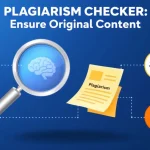AI Detection Avoidance Guide
Is this tool helpful?
How to Use the AI Detection Avoidance Strategy Generator Effectively
To maximize the benefits of our AI Detection Avoidance Strategy Generator, follow these step-by-step instructions:
- Brief description of common AI detection algorithms and methods: In this field, provide a concise overview of AI detection techniques. For example, you might enter “Natural Language Processing (NLP) algorithms, statistical analysis of text patterns, and machine learning models trained on large datasets of human and AI-generated content.”
- Type of content being created: Specify the type of content you’re working on. For instance, you could input “Research paper for a graduate-level economics course” or “Marketing copy for a tech startup’s website.”
- Specific guidelines or requirements for the content (Optional): If applicable, enter any specific requirements or guidelines for your content. An example could be “Must include at least 5 peer-reviewed sources and adhere to APA 7th edition formatting” or “Needs to incorporate industry-specific jargon and maintain a conversational tone.”
- Click the “Generate AI Detection Avoidance Strategies” button to receive tailored recommendations.
- Review the generated strategies in the results section.
- Use the “Copy to Clipboard” button to easily transfer the strategies to your preferred document or editing tool.
By providing accurate and detailed information in each field, you’ll receive more precise and effective strategies to avoid AI detection while maintaining the integrity and quality of your content.
Understanding AI Detection Avoidance: A Comprehensive Guide
In an era where artificial intelligence (AI) is increasingly used to generate written content, the need for strategies to avoid AI detection has become paramount. This AI Detection Avoidance Strategy Generator is a powerful tool designed to help content creators, students, and professionals produce original, human-like text that can bypass common AI detection algorithms.
The Purpose and Benefits of AI Detection Avoidance
The primary purpose of this tool is to assist users in creating content that appears more human-like and original, even when starting with AI-generated text or incorporating AI assistance in the writing process. By implementing the strategies provided by this generator, users can:
- Maintain academic integrity in educational settings
- Produce more authentic and engaging content for readers
- Avoid potential penalties or rejections in publication processes
- Enhance the credibility of their written work
- Develop stronger writing skills by understanding and applying various linguistic techniques
How the AI Detection Avoidance Strategy Generator Works
This tool utilizes advanced algorithms and natural language processing techniques to analyze the input provided by the user. Based on this information, it generates a comprehensive set of strategies tailored to the specific content type and requirements. The strategies are designed to address various aspects of writing that AI detection algorithms typically focus on, such as:
- Sentence structure and complexity
- Vocabulary usage and diversity
- Stylistic elements and rhetorical devices
- Coherence and logical flow of ideas
- Contextual relevance and domain-specific knowledge integration
Benefits of Using the AI Detection Avoidance Strategy Generator
1. Customized Strategies
One of the primary advantages of this tool is its ability to provide tailored strategies based on the specific type of content you’re creating. Whether you’re working on an academic paper, a blog post, or marketing copy, the generator takes into account the unique requirements and characteristics of your content to offer the most relevant and effective suggestions.
2. Time-Saving
Researching and developing strategies to avoid AI detection can be a time-consuming process. This generator streamlines the process by instantly providing a comprehensive set of techniques, saving you valuable time and allowing you to focus on the actual content creation.
3. Continuous Learning and Adaptation
As AI detection algorithms evolve, so does our strategy generator. It is regularly updated to incorporate the latest insights and techniques in AI detection avoidance, ensuring that users always have access to the most current and effective strategies.
4. Educational Value
Using this tool not only helps in avoiding AI detection but also serves as an educational resource. Users can learn about various writing techniques, stylistic elements, and linguistic strategies that can improve their overall writing skills.
5. Versatility
The AI Detection Avoidance Strategy Generator is versatile enough to cater to a wide range of content types and requirements. Whether you’re a student working on a research paper, a content marketer creating web copy, or a novelist drafting a manuscript, this tool can provide valuable insights and strategies.
Addressing User Needs and Solving Specific Problems
Problem: Maintaining Originality in Academic Writing
For students and researchers, maintaining originality in their work is crucial. The AI Detection Avoidance Strategy Generator addresses this need by providing techniques to rephrase and restructure content while preserving the original meaning and intent. For example, if a user is working on a psychology research paper, the tool might suggest:
- Incorporating discipline-specific terminology and concepts unique to psychological research
- Varying sentence structures to include more complex, compound-complex sentences typical in academic writing
- Integrating personal insights and critical analysis to demonstrate original thinking
- Using transitional phrases and logical connectors to improve the flow of arguments
Problem: Creating Engaging Marketing Content
For marketers, the challenge lies in creating content that is both persuasive and authentic. The generator might provide strategies such as:
- Incorporating brand-specific language and tone to maintain consistency
- Suggesting the use of rhetorical devices like metaphors or analogies to make the content more engaging
- Recommending the integration of industry-specific case studies or examples to add credibility
- Advising on the use of active voice and power words to create a more impactful message
Practical Applications and Use Cases
Use Case 1: Graduate Student Writing a Thesis
Sarah, a graduate student in Environmental Science, is writing her thesis on the impact of microplastics on marine ecosystems. She uses the AI Detection Avoidance Strategy Generator to ensure her work remains original and passes the university’s strict plagiarism checks. The tool provides her with the following strategies:
- Incorporate personal observations from field research to add unique insights
- Use domain-specific jargon and technical terms related to marine biology and environmental science
- Vary sentence structures, mixing short, impactful statements with longer, more complex explanations
- Integrate critical analysis of existing research, highlighting gaps and proposing new perspectives
By implementing these strategies, Sarah successfully completes her thesis, demonstrating originality and depth of knowledge in her field.
Use Case 2: Content Marketer Creating a White Paper
John, a content marketer for a SaaS company, is tasked with creating a white paper on the future of cloud computing. He uses the AI Detection Avoidance Strategy Generator to ensure his content is engaging, informative, and appears authentically human-written. The tool suggests:
- Incorporate industry-specific case studies and real-world examples
- Use a mix of data-driven insights and expert opinions to support key points
- Employ storytelling techniques to make complex technological concepts more accessible
- Integrate company-specific insights and unique value propositions naturally throughout the content
John applies these strategies, resulting in a compelling white paper that effectively showcases his company’s expertise while avoiding any suspicion of AI-generated content.
Frequently Asked Questions (FAQ)
Q1: Can this tool guarantee that my content will pass all AI detection tests?
A1: While our AI Detection Avoidance Strategy Generator provides highly effective techniques, it’s important to note that AI detection technologies are continually evolving. The strategies offered significantly increase the likelihood of your content appearing human-written, but we recommend using them in conjunction with your own critical thinking and writing skills for the best results.
Q2: Is using this tool considered ethical?
A2: The ethical use of this tool depends on your intentions and how you apply the strategies. It’s designed to help users improve their writing and create more authentic content, not to deceive or misrepresent. We encourage users to maintain academic and professional integrity while using these strategies to enhance their writing skills.
Q3: How often are the strategies updated?
A3: Our team of experts continuously monitors advancements in AI detection technologies and updates the strategy database regularly. This ensures that users always have access to the most current and effective techniques for creating human-like content.
Q4: Can I use this tool for languages other than English?
A4: Currently, the AI Detection Avoidance Strategy Generator is optimized for English content. However, many of the general principles and strategies can be applied to writing in other languages. We’re working on expanding language support in future updates.
Q5: How does this tool differ from a paraphrasing tool?
A5: Unlike paraphrasing tools that simply rephrase existing text, our AI Detection Avoidance Strategy Generator provides comprehensive strategies for creating original content. It offers techniques for structuring arguments, incorporating personal insights, and adapting writing style to specific contexts, going far beyond mere word substitution.
Q6: Is this tool suitable for creative writing, such as fiction?
A6: Absolutely! The AI Detection Avoidance Strategy Generator can be particularly useful for creative writers. It can suggest techniques for developing unique narrative voices, incorporating vivid descriptions, and crafting engaging dialogues that feel authentically human-created.
Q7: How can I ensure that I’m not overusing these strategies?
A7: The key is to use the strategies as guidelines rather than rigid rules. Incorporate them naturally into your writing process, and always prioritize clarity and coherence. Remember, the goal is to enhance your natural writing style, not to create an artificially complex text.
Q8: Can this tool help improve my overall writing skills?
A8: Yes! By exposing you to various writing techniques and stylistic elements, the AI Detection Avoidance Strategy Generator can significantly contribute to improving your writing skills. Pay attention to the suggested strategies and try to understand the reasoning behind them to enhance your writing capabilities over time.
Q9: Is there a limit to how many times I can use this tool?
A9: There are no restrictions on how frequently you can use the AI Detection Avoidance Strategy Generator. We encourage users to utilize it as often as needed to refine their writing and develop their skills in creating authentic, engaging content.
Q10: Can I use this tool for collaborative writing projects?
A10: Certainly! The strategies provided by this tool can be valuable in collaborative writing settings. They can help maintain a consistent style across multiple authors and ensure that the final product appears cohesive and authentically human-written.
By addressing these common questions, we hope to provide users with a comprehensive understanding of the AI Detection Avoidance Strategy Generator and its applications. Remember, the ultimate goal is to enhance your writing skills and produce high-quality, original content that effectively communicates your ideas to your intended audience.
Important Disclaimer
The calculations, results, and content provided by our tools are not guaranteed to be accurate, complete, or reliable. Users are responsible for verifying and interpreting the results. Our content and tools may contain errors, biases, or inconsistencies. We reserve the right to save inputs and outputs from our tools for the purposes of error debugging, bias identification, and performance improvement. External companies providing AI models used in our tools may also save and process data in accordance with their own policies. By using our tools, you consent to this data collection and processing. We reserve the right to limit the usage of our tools based on current usability factors. By using our tools, you acknowledge that you have read, understood, and agreed to this disclaimer. You accept the inherent risks and limitations associated with the use of our tools and services.







